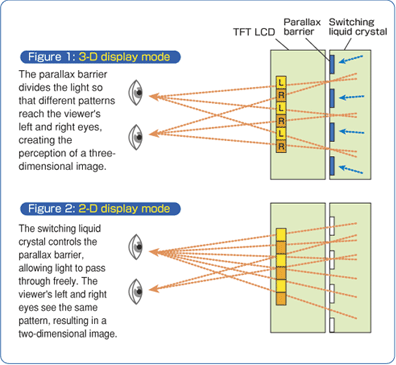Parallax Barrier Technology - 3D Without Glasses

On the surface, parallax-barrier technology sounds like it should be the be all and end all of 3D television... Because it doesn't require you to wear any glasses. None at all.
The problem is that, at the moment, you don't get to see the 3D effects unless you're sitting in a very specific position.
Parallax-barrier technology requires a barrier in front of a screen. The screen shows both the left and the right images, and the barrier effectively has slits in it that separate them out. If you look at it from exactly the right spot, the slits will allow the left image through to your left eye, and the right image through to your right eye, with no overlap.
This isn't like one of those crazy Victorian drum things where you spin the drum and look through the slits to see the horses go around - the barrier and slits aren't things you'd actually see.
Sharp is a pioneer of this technology. They use something they call a "switching screen" to implement the parallax barrier, that enables their screens to be switched between 3D and 2D. The switching screen is effectively a second LCD screen placed in front of a regular LCD screen. You can see a diagram showing roughly how it works to the right.
So far the parallax barrier technology has mainly just been used for individual gaming on small, handheld screens. Because it requires you to sit in a specific position to get the 3D effect, it's not ideal for watching TV with your partner or friends.
But I think it looks like it might be the 3D technology of the future, and manufacturers do appear to be finding ways to increase the angle over which you can see a 3D image. For example, check out this news report of a 21 inch parallax display from Toshiba that allows up to a 30 degree horizontal viewing angle (which is, I think, a heck of a lot wider than most parallax screens have managed so far). It does, however, appear to be a long way from becoming commercially available.
The Toshiba screen uses a "multi-parallax" method to increase the potential viewing angle of the display. From what I can tell, the system is actually showing 9 separate pairs of images across the 30 degree angle - the idea being that you'll hopefully be sitting in the right place for at least one pair of images (one for your left eye, one for your right). I'm not convinced that it's a particularly neat way to solve the viewing-position problem, but maybe this technique can be taken further to give us true see-from-all-around-the-room 3D television.
In summary, for parallax-barrier technology all I can really say is "watch this space". I'm excited that in a few years big-screen parallax-barrier 3D TVs with wide viewing angles might be readily available on the high street, but for now I don't think it's really an option.